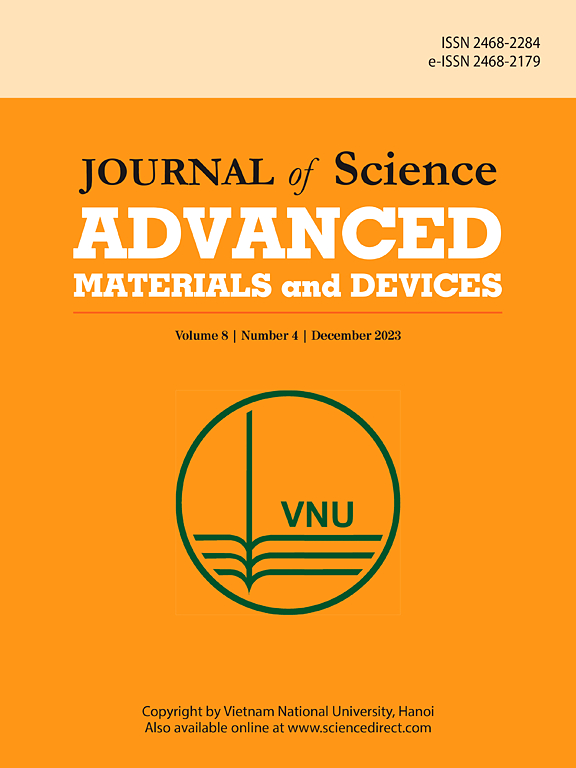一种新型的双层水凝胶/纤维创面敷料,含有寻常镰孢菌提取物和绿色合成氧化锌纳米颗粒,用于促进创面愈合
IF 6.8
3区 材料科学
Q1 MATERIALS SCIENCE, MULTIDISCIPLINARY
Journal of Science: Advanced Materials and Devices
Pub Date : 2025-04-23
DOI:10.1016/j.jsamd.2025.100896
引用次数: 0
摘要
由于伤口愈合是一个多方面的过程,大多数传统支架不像天然细胞外基质那样复杂。因此,它们不能为内源性组织重建提供合适的生态位。为了克服这一问题并加速愈合过程,我们开发了一种仿生双层敷料,该敷料由海藻酸钠/明胶水凝胶和绿色合成氧化锌纳米粒子(ZnO NPs)作为真皮层和静电纺聚丙烯腈(PAN)纳米纤维作为表皮基质组成。FESEM图像证实了无珠、光滑、连续的PAN纤维的存在,并在水凝胶表面有适当的结合。该复合材料具有良好的抗拉强度(5±0.05 MPa)、弹性模量(0.4±0.1 MPa)和断裂伸长率(50±5%)等力学性能,具有良好的溶胀能力和降解速率。该敷料对革兰氏阴性(20±2 mm)和革兰氏阳性(21±2 mm)菌株均有抑制作用,通过控制ZnO NPs在L929细胞附近的释放而无任何毒性。在体内实验中,通过促进伤口收缩、胶原合成、再上皮化和新组织形成,进一步证实了这种有趣的双层敷料对伤口修复的高效能。本文章由计算机程序翻译,如有差异,请以英文原文为准。

A novel bilayer hydrogel/ fibrous wound dressing with Falcaria vulgaris extract and green synthesized ZnO nanoparticles for enhanced wound healing
Since wound healing is a multifaceted process, most conventional scaffolds do not resemble the complexity of the natural extracellular matrix. Thus, they cannot provide a suitable niche for endogenous tissue reconstruction. To overcome this issue and to accelerate the healing process, we developed a biomimetic double-layer dressing comprising sodium alginate/gelatin hydrogel loaded with Falcaria Vulgaris extract and green synthesized zinc oxide nanoparticles (ZnO NPs) as the dermal layer and electrospun polyacrylonitrile (PAN) nanofibers as the epidermis matrix. FESEM images confirmed the existence of bead-free, smooth, and continuous PAN fibers with proper binding on the surface of the hydrogel. The multifunctional double layer dressing revealed admirable mechanical characteristics including tensile strength (5 ± 0.05 MPa), elastic modulus (0.4 ± 0.1 MPa) and elongation at break (50 ± 5 %) along with proper swelling capacity and degradation rate. Such dressing exhibited an inhibition zone against both gram-negative (20 ± 2 mm) and gram-positive (21 ± 2 mm) bacterial strains via controlled release of ZnO NPs without any toxicity in the vicinity of L929 cells. The high potency of such intriguing bilayer dressing for wound repair was further confirmed via the promotion of wound contraction, collagen synthesis, re-epithelialization, and new tissue formation during in vivo assay.
求助全文
通过发布文献求助,成功后即可免费获取论文全文。
去求助
来源期刊

Journal of Science: Advanced Materials and Devices
Materials Science-Electronic, Optical and Magnetic Materials
CiteScore
11.90
自引率
2.50%
发文量
88
审稿时长
47 days
期刊介绍:
In 1985, the Journal of Science was founded as a platform for publishing national and international research papers across various disciplines, including natural sciences, technology, social sciences, and humanities. Over the years, the journal has experienced remarkable growth in terms of quality, size, and scope. Today, it encompasses a diverse range of publications dedicated to academic research.
Considering the rapid expansion of materials science, we are pleased to introduce the Journal of Science: Advanced Materials and Devices. This new addition to our journal series offers researchers an exciting opportunity to publish their work on all aspects of materials science and technology within the esteemed Journal of Science.
With this development, we aim to revolutionize the way research in materials science is expressed and organized, further strengthening our commitment to promoting outstanding research across various scientific and technological fields.
 求助内容:
求助内容: 应助结果提醒方式:
应助结果提醒方式:


